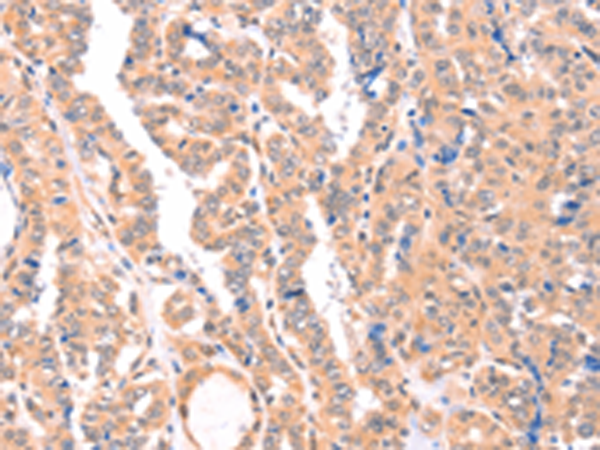

| WB | 咨询技术 | Human,Mouse,Rat |
| IF | 咨询技术 | Human,Mouse,Rat |
| IHC | 1/100-1/300 | Human,Mouse,Rat |
| ICC | 技术咨询 | Human,Mouse,Rat |
| FCM | 咨询技术 | Human,Mouse,Rat |
| Elisa | 1/2000-1/5000 | Human,Mouse,Rat |
| Aliases | X11L; MINT2; LIN-10; HsT16821; X11-BETA; D15S1518E; MGC:14091 |
| Host/Isotype | Rabbit IgG |
| Antibody Type | Primary antibody |
| Storage | Store at 4°C short term. Aliquot and store at -20°C long term. Avoid freeze/thaw cycles. |
| Species Reactivity | Human |
| Immunogen | Synthetic peptide of human APBA2 |
| Formulation | Purified antibody in PBS with 0.05% sodium azide and 50% glycerol. |
+ +
以下是关于APBA2抗体的3篇参考文献及其摘要概括:
---
1. **文献名称**:*Mint2/X11β: An Adaptor Protein That Regulates Aβ Production Through Interaction with APP*
**作者**:Tomita S, et al.
**摘要**:该研究阐明了APBA2(Mint2/X11β)与淀粉样前体蛋白(APP)的相互作用,利用特异性抗体通过免疫共沉淀和免疫荧光技术验证了二者的结合,揭示了APBA2在调控APP加工及Aβ生成中的功能,为阿尔茨海默病机制提供了重要依据。
2. **文献名称**:*Characterization of the X11β/Mint2 Antibody for Neuronal Localization Studies*
**作者**:Borg JP, et al.
**摘要**:作者开发并验证了一种针对APBA2的多克隆抗体,通过Western blot和免疫组化证实其在啮齿类及人脑组织中的特异性表达,证明APBA2主要富集于神经元突触,支持其在神经信号转导中的作用。
3. **文献名称**:*APBA2 Modulates APP Trafficking and Amyloid-β Pathology in Alzheimer's Disease Models*
**作者**:Saito Y, et al.
**摘要**:研究利用APBA2抗体在转基因小鼠模型中分析其表达变化,发现APBA2缺失导致APP运输异常并加剧Aβ沉积,提示其作为阿尔茨海默病潜在治疗靶点。抗体应用包括组织染色及蛋白互作检测。
---
以上文献均聚焦APBA2抗体的开发、验证及其在疾病机制研究中的应用,涵盖蛋白质互作、亚细胞定位及病理模型分析。如需更多文献,可进一步检索PubMed或Web of Science数据库。
The APBA2 (Amyloid Beta Precursor Protein Binding Family A Member 2) antibody targets a protein encoded by the APBA2 gene, also known as X11-like (X11L) or Mint1. APBA2 is a member of the neuronal adaptor protein family, primarily expressed in the brain, where it plays a critical role in synaptic vesicle trafficking, neurotransmitter release, and neuronal signal transduction. It interacts with the cytoplasmic domain of the amyloid precursor protein (APP), influencing its processing and potentially modulating the production of β-amyloid peptides, which are implicated in Alzheimer’s disease pathogenesis. APBA2 contains two conserved domains: a phosphotyrosine-binding (PTB) domain that mediates binding to APP, and a PDZ domain involved in protein-protein interactions at synaptic junctions.
Antibodies against APBA2 are widely used in neuroscience research to investigate its expression, localization, and interactions in neuronal tissues or cell models. They enable techniques like Western blotting, immunohistochemistry, and co-immunoprecipitation to study APBA2's role in APP metabolism, synaptic plasticity, and neurodegenerative disorders. Such antibodies are often validated for specificity across human, mouse, and rat samples, aiding comparative studies. Research on APBA2 antibodies also contributes to understanding its potential as a therapeutic target or biomarker in Alzheimer’s disease and related dementias.
×